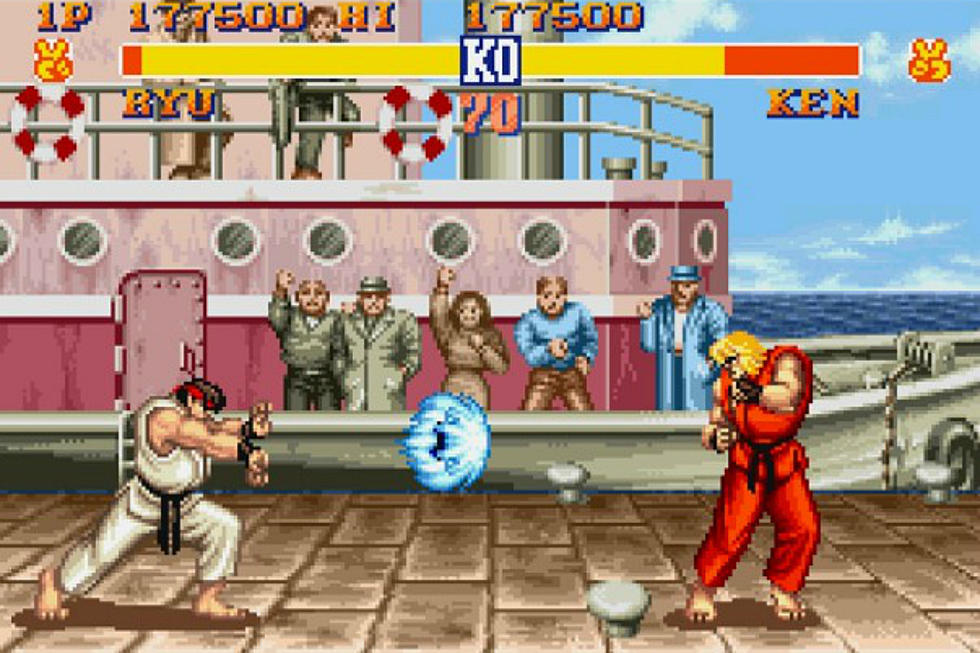
The History of Fighting Games: Part 2 – From The Pits to the Streets
Climbing Out of the Pits
It’s tempting to skip directly from 1987’s Street Fighter to 1991’s Street Fighter II to celebrate the success Capcom had in refining the fighting game formula, but a lot can happen in four years. Many companies began throwing their chips into the 8 and 16 bit fighting game pot. Some companies, like Home Data, tried to outdo Street Fighter with superior graphics in games like Last Apostle Puppet Show, but the gameplay of these semi-clones never quite lived up to Capcom’s original. Other companies, like Technos, started adding fighting game modes to other genres of game. You may remember popular example, the versus mode in Double Dragon, which wasn’t all that deep but did let you play as Abobo, and that was enough for most of us.
Developers looking to make more of a “pure” fighting game, however, started fooling around with the idea of three dimensional movement. We had already seen primitive 3D movement in wrestling games such as the Japan-only game Appoooh published in 1984. Taito released a 16 bit “3D” fighter entitled Kageki: Fists of Steel in 1988, which allowed both fighters to move around a square ring but only allowed them simple, two-button weak attack/strong attack controls. Even though there was a new dimension to movement, fights usually boiled down to who mashed the right button at the right time.
Perhaps the most well-known fighting game to try and take advantage of 3D environments at the time was Pit Fighter. This Atari game made a brief splash in arcades in 1990 with its use of digitized actors. Instead of pixelated sprites, actual people were shown on screen kicking the crap out of each other, and this was way before Mortal Kombat ever showed off its first bloody fatality.
Unfortunately, Pit Fighter had numerous issues. Its three button punch/kick/jump control scheme was far too simple and once again caused most matches to reduce themselves to button mashing. Its difficulty curve was near impossible, designed to make foolish kids quickly waste their parents’ quarters. While it introduced interesting concepts like weapons that you could pick up off the floor, the hit-detection was so bad attacks would routinely whiff through opponents even if you were right up against them. It is now widely regarded as one of the worst fighting games of all time, but back then, it was the best we had.
The SNK Sneak
As we said The History of Fighting Games part 1, the original creators of Street Fighter, Takashi Nishiyama and Hiroshi Matsumoto had left Capcom by the time the company decided to attempt to create a Street Fighter II. It was there they began work on Street Smart, a spiritual successor to Street Fighter.
Street Smart still had more in common with beat ‘em ups and karate games than it did with current day fighting games. While it did feature the ability to select between two character, karate man and wrestler, its controls were once again minimized to punch, kick and jump. It did interesting things with the concept of hit-stun and it had a very simple beat ‘em up style combo system that introduced players to the concept of juggling. It even let two players team up in co-op play, something most fighters of today don’t even have. King of Fighters fans may also recognize karate man as having similarities to both Ryo and Takuma as he inspired the creation of both characters later on in SNK’s lifetime.
Unfortunately, Street Smart didn’t quite cut it as a fighting game because of its mechanics. Each attack in the game caused you to move forward, which would cause you pass right through the opponent while you had him stuck in a combo. Controls were still very simple and could easily be mashed. The characters in the game didn’t have anywhere near as much personality as the characters in Street Fighter did, and in the end, most arcade goers gravitated toward Capcom’s original release instead of SNK’s copycat.
But SNK, Nishiyama and Matsumoto weren’t done yet. They had seen the success the original Street Fighter had and they were pushing hard to make that magic happen again. In 1990, the Neo-Geo arcade platform made its debut, and without a single fighting game. SNK was going to fix this, and so it started work on the Neo-Geo’s first fighter, Fatal Fury: The King of Fighters.
Fatal Fury was kind of a hybrid game, smack dab between the boss-run gameplay of karate games we had become used to, and the fighting game formula that we are familiar with today. It had a selectable roster of three characters: Terry Bogard, Andy Bogard and Joe Higashi. However, eight more CPU controlled characters comprised the rest of the roster. Some of these you may recognize from later King of Fighters games including Hwa-Jai, Billy Kane, Raiden and Geese Howard.
Once again the focus of the game was to defeat these eight CPU bosses, rather than your friend. You would still have to fight your friend if they stepped up next to you and put a quarter into the machine, but before you squared off you actually got to fight against the computer together, which was incredibly abusable and fun.
Fatal Fury fooled around with a lot of other fighting game innovations as well. It wasn’t full 3D, but it did allow its fighters to change “lanes” by jumping into the foreground and background. It had special moves but these moves weren’t a secret. Instead, they were explained to the player between matches. It had a simple three-button punch/kick/throw control scheme but character move lists were expanded by attacks changing when you were crouching, jumping, standing, and so forth. It was also one of the first games to introduce the invincible “roll” maneuver.
It’s also worth noting that the home console versions of Fatal Fury were received far better than the arcade versions. The two lane system was totally removed, as was the co-op fighting aspect. Instead, we had simple 2D fighting, just like the fighting game crowd wanted. In addition, the entire roster was unlocked for play on the home console version, in versus mode at least, making it far more interesting as a competitive title. Unfortunately, the SNES version of Fatal Fury was released in 1992 in Japan and 1993 in America, and by then Capcom had already released its next fighting game opus.
The Not So Final Fight
In case you haven’t noticed, a lot of companies who would have otherwise made new fighting games were experimenting with the beat ‘em up formula. This is mostly due to the astounding success Double Dragon had as an arcade game in 1987. Even though it came out around the same time that Street Fighter did, many viewed the beat ‘em up as the normal progression from the karate game. After all, karate games had you fighting a linear set of characters in one-on-one matches on small stages. What could be cooler than letting you fight a whole bunch of characters on much larger stages?
So when Capcom asked relative newcomers Akira Nishitani and Akira Yasuda to create a sequel to their hit Street Fighter, development was quickly pushed toward the beat ‘em up genre. Nishitani, otherwise known as Nin-Nin, and Yasuda, otherwise known as Akiman, came up with a game that was actually quite similar to both Street Smart and Fatal Fury. It was a beat ‘em up with a two button control scheme, a pseudo 3D movement scheme, and a three character roster. Even though the game was awesome, Capcom didn’t quite feel as though it fit the Street Fighter mold that they were looking for. So they rebranded the title with a new name and released it anyway and lo and behold, Final Fight was born.
Final Fight followed the exploits of Haggar, a former pro-wrestler turned mayor, Cody, a street thug with a heart of gold, and Guy, a ninja who was… well a frickin’ ninja. Their goal was to rescue Cody’s girlfriend Jessica from the Mad Gear gang. In its own way, Final Fight refined the beat ‘em up formula much like Street Fighter II would for fighting games. Its grappling system was probably its high point, allowing enemies to be thrown into other enemies or even into parts of the stage. It had a smooth combo system that allowed you chain your hits together into impressive attacks, an expansive weapon and item system that allowed you to use tools that fit characters best, like Haggars pipe and Guy’s knife. It also had some of the nicest looking life-bars of any game In existence, and these life-bars would eventually be copy-pasted to Street Fighter II.
Because of its origin as a proposed sequel to Street Fighter II, Capcom quickly decided that Street Fighter and Final Fight took place in the same universe. Guy and Cody eventually showed up in the Street Fighter Alpha series, while Haggar made his way into Marvel vs. Capcom 3. Enemies from the game, Hugo and Poison would also eventually make their way into the Street Fighter series. Hugo first appeared as a playable character in the Street Fighter III titles, while Poison got her start in Street Fighter X Tekken and is now going to be playable in Ultra Street Fighter IV. Poison also created a controversy when translations of the Final Fight instruction manual suggested that she may be a transvestite or even a post-op transsexual. To this day, Capcom isn’t telling, but that hasn't stopped the character from becoming a fan-favorite for cosplayers around the world.
Capcom Gets It Right
After Final Fight, Akiman and Nin-Nin decided to return to the drawing board for another attempt at creating a worthy sequel to Street Fighter. This time, they tried to stick to the original formula, one character running through a variety of one-on-one fights until they get to a boss. They kept basically everything from the original game intact, including the light/medium/hard punch and kick control scheme, the tap up to jump motion scheme, and the simple 2D plane fighting. In many ways the game was identical to the original Street Fighter experience.
However, they decided to mix things up a bit when it came to the roster. Seeing how well players responded to games that let you choose your character, the designers decided to open the playable roster up. The game’s roster wouldn’t be much bigger than any other fighting game or karate game on the market. The only difference is instead of one or two playable characters facing off against 10 or so computer controlled bosses, the game would feature eight playable characters facing off against only 4 hidden CPU bosses. Players would still have to defeat the entire playable roster before they got to the boss levels, but could fight in many different ways to get there.
The funny thing is, none of this really mattered. You never saw people playing single-player on Street Fighter II cabinets. It was all about the versus mode, a trend that has stuck with fighting games to this day. Players would come from all over just to put their quarter up on your local machine and wait for their turn. If you were one of the kids that knew how to do something crazy, like combo, or even better glitch the game, it felt like you had a hidden treasure of knowledge. You’d share this knowledge with other players, and soon a community of strategy was born, even if that strategy just happened to be explaining how to hadouken.
Speaking of special moves, Street Fighter II introduced far more special move conventions into the game as well. It created the first “charge” moves, which forced you to hold a direction for two seconds before pressing an opposite direction and a button. Charge moves were powerful but couldn’t be done on reaction, making them good choices for more defensive characters. Street Fighter II also introduced the “rapid button press” move, such as Chun-Li’s lightning legs or E. Honda’s hundred-hand slap. Not only did these moves make button mashers feel cooler than they actually were, they also discouraged mashing in general, as they would prevent the move you actually wanted from coming out.
Street Fighter II was all about emergent gameplay. While the game was originally planned to operate the same way any other karate game did, with single hits traded back and forth, players quickly found ways to abuse the system. “Canceling,” for example, took advantage of quirks in the game’s input system to cut of the ending lag of moves. The simplest form of canceling, which happened when you landed from a jump, allowed you to string very damaging moves together, easily doing half of your opponent’s life in damage or more. Other players found that good timing would simply allow you to string normal attacks together, creating the first combos.
Ryu and Ken returned in Street Fighter II, although originally the thought was to introduce an entirely new cast of characters. In the first release, they were once again identical to each other, though this quickly changed in re-releases. They were joined by E. Honda, Blanka, Guile, Chun-Li, Zangief and Dhalsim, some of the most recognizable faces of fighting games today. The boss roster included Balrog, based off Mike from Street Fighter I, Vega, an acrobatic pretty boy who wore a mask, M. Bison, a powerful dictator with Psycho power, and Sagat, the former boss of Street Fighter I. All of these characters are still playable in current day Street Fighter games.
As awesome as Street Fighter II was, it had its issues. Random damage was one of them, which could determine the outcome of a match by pure chance if you managed to land a couple lucky moves. Blocking was also incredibly powerful early on in the game’s life time, making it easy to back yourself into a corner and throw fireballs. This is where the infamous “turtling” term came from, and unless you were a skilled player who at least knew how to not button mash, this would frustrate you for days. You also couldn’t select the same character in a versus match, so if two players’ favorite character was Guile, one would simply be out of luck.
Nonetheless, the game was a hit. Its characters were interesting, its music was awesome, and its stages were amazing. They would even react to the fight, with statues and boxes getting broken as fighters were flung around the arena. It also solidified the formula for fighting game HUDs and stages. The 2D plane was now the industry standard, and two lifebars draining toward the center was the optimal layout for every fighting game to come.
It wasn’t just the fans who took notice of Capcom’s near perfect formula. Other companies took notice as well. Soon everyone had a fighting game to put on the market featuring samurai or dinosaurs or giant lumps of clay, and Capcom had to compete by continually updating its Street Fighter II formula. We'll take a closer look at these re-releases and copycats in the next installment of our ongoing History of Fighting Games series: Attack of the Clones.
More From Arcade Sushi









